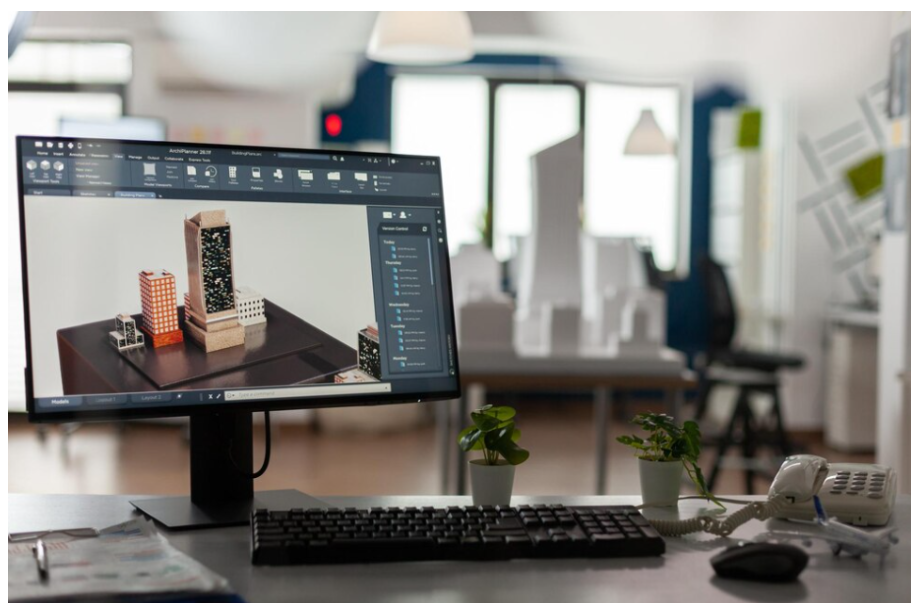The architectural world is experiencing a profound shift in the way professionals approach their projects, thanks to the advent of Building Information Modeling (BIM) technology. BIM is a digital methodology that transcends traditional architectural practices, providing a comprehensive platform for architects, engineers, and construction teams to collaboratively plan, design, construct, and manage buildings and infrastructure.
At its core, BIM involves creating intelligent, 3D digital models of structures that are more than just visual representations; they are rich repositories of data and information about the building’s components, materials, systems, and lifecycle details.
Table of Contents
Evolution of BIM in Architectural Practices
To truly appreciate the significance of BIM in contemporary architecture, it’s crucial to understand its evolutionary journey. In the past, architects relied heavily on 2D drawings and physical models to convey design intent.
However, as the complexity of architectural projects grew and the need for more efficient design and construction processes became apparent, BIM technology emerged. This transition from conventional drafting to digital modeling marked a pivotal moment in architectural history, facilitating collaboration, data-driven decision-making, and project optimization.
Enhancing Collaboration and Communication
One of the hallmarks of BIM technology is its unparalleled ability to enhance collaboration and communication among the various stakeholders in a construction project. Unlike the traditional approach where siloed communication and fragmented document exchange were commonplace, BIM fosters a shared digital environment where architects, engineers, contractors, and clients can work seamlessly together. This collaborative approach allows for real-time data sharing, the quick resolution of design issues, and improved decision-making.
Streamlining Design and Visualization
BIM’s transformative capability lies in its ability to create comprehensive 3D models that serve as the digital backbone of the design and construction process. These models are not static representations; they are dynamic, intelligent repositories of information.
Architects can efficiently explore different design configurations, visualize how changes affect the project, and conduct in-depth feasibility studies. BIM technology empowers architects to make well-informed design decisions, thereby optimizing the creative process.
Optimizing Construction and Project Management
The construction phase of a project is where BIM truly shines. Detailed data within the BIM model enables architects and construction teams to create precise construction schedules, allocate resources efficiently, and mitigate potential conflicts before they escalate.
This results in streamlined project timelines and reduced cost overruns. The capacity to address issues proactively significantly enhances project management, leading to more successful and on-budget projects.
The Importance of 3D Rendering Services
Within the BIM ecosystem, the integration of 3D rendering services takes architectural visualization to new heights. High-quality, realistic renderings are generated from the BIM model, allowing clients to gain a crystal-clear understanding of the final design. These renderings are not just aesthetic; they serve as powerful communication tools, enabling clients to provide valuable feedback and make decisions confidently, all of which is essential for creating a design that truly resonates with the client’s vision.
Sustainable Design and Environmental Analysis
Sustainability is at the forefront of contemporary architectural concerns, and BIM technology plays a pivotal role in achieving sustainable design goals.
BIM tools provide architects with the ability to analyze a building’s environmental impact comprehensively. This includes assessing energy consumption, optimizing daylighting, and making informed material choices that reduce a structure’s ecological footprint.
As a result, architects can make data-driven decisions that lead to more sustainable and eco-friendly buildings, aligning with modern environmental imperatives.
Cost Estimation and Budget Control
Accurate cost estimation is paramount for any architectural project’s success. BIM technology offers architects the capacity to create precise cost estimates based on the wealth of information contained within the digital model. This not only facilitates budget planning but also empowers architects to make cost-effective design decisions. These decisions are grounded in real-world cost considerations, ensuring that projects align with their financial goals.
Facility Management and Building Lifecycle
The utility of BIM extends far beyond the project’s completion. The digital model continues to serve a purpose throughout the building’s lifecycle. Building owners and operators can harness the data within the BIM model to facilitate efficient maintenance, reduce long-term operational costs, and plan renovations. This transition from a design and construction tool to an ongoing asset for facility management demonstrates the long-lasting impact of BIM technology.
BIM in Urban Planning and Infrastructure
BIM is not confined to individual building projects; it plays a significant role in urban planning and infrastructure development. City planners and civil engineers can employ BIM to create comprehensive 3D models of entire urban landscapes.
These models facilitate the analysis of traffic flow, assessment of infrastructure needs, and the design of sustainable cities for the future. BIM is revolutionizing the way urban planners approach complex, large-scale projects, ensuring that they are designed and executed with precision.
The Challenges and Future Trends
While BIM has revolutionized architectural practices, it is not without its challenges. The architectural community must address issues like data interoperability, initial adoption costs, and the need for comprehensive training and education in BIM methodologies.
However, the future of BIM in architecture is highly promising. Emerging trends, such as augmented reality, artificial intelligence, and blockchain integration, are set to further enhance BIM’s capabilities, shaping the future of architecture into a more efficient, sustainable, and technology-driven discipline.
Wrapping Up
Building Information Modeling technology has become an indispensable tool in contemporary architecture. It has redefined the way architects and their collaborators work together, from the early design phases to facility management and beyond. The future of BIM promises even greater integration and innovation, ensuring that architecture continues to evolve in tandem with technology’s advancements.











